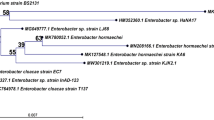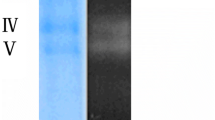Abstract
In this study, we cloned the gene encoding goose-type (G-type) lysozyme with chitinase (Ra-ChiC) activity from Ralstonia sp. A-471 genomic DNA library. This is the first report of another type of chitinase after the previously reported chitinases ChiA (Ra-ChiA) and ChiB (Ra-ChiB) in the chitinase system of the moderately thermophilic bacterium, Ralstonia sp. A-471 and also the first such data in Ralstonia sp. G-type lysozyme gene. It consisted of 753 bp nucleotides, which encodes 251 amino acids including a putative signal peptide. This ORF was modular enzyme composed of a signal sequence, chitin-binding domain, linker, and catalytic domain. The catalytic domain of Ra-ChiC showed homologies to those of G-type lysozyme (glycoside hydrolases (GH) family 23, 16.8%) and lysozyme-like enzyme from Clostridium beijerincki (76.1%). Ra-ChiC had activities against ethylene glycol chitin, carboxyl methyl chitin, and soluble chitin but not against the cell wall of Micrococcus lysodeikticus. The enzyme produced α-anomer by hydrolyzing β-1,4-glycosidic linkage of the substrate, indicating that the enzyme catalyzes the hydrolysis through an inverting mechanism. When N-acetylglucosamine hexasaccharide [(GlcNAc)6] was hydrolyzed by the enzyme, the second and third glycosidic linkage from the non-reducing end were split producing (GlcNAc)2 + (GlcNAc)4 and (GlcNAc)3 + (GlcNAc)3 of almost the same concentration in the early stage of the reaction. The G-type lysozyme hydrolyzed (GlcNAc)6 in an endo-splitting manner, which produced (GlcNAc)3 + (GlcNAc)3 predominating over that to (GlcNAc)2 + (GlcNAc)4. Thus, Ra-ChiC was found to be a novel enzyme in its structural and functional properties.









Similar content being viewed by others
References
Arakane Y, Hoshika H, Kawashima N, Fujiya-Tsujimoto C, Sasaki Y, Koga D (2000) Comparison of chitinase isozymes from Yam tuber-enzymatic factor controlling the lytic activity of chitinases. Biosci Biotechnol Biochem 64:723–730
Grutter MG, Weaver LH, Mattews BW (1983) Goose lysozyme structure: an evolutionary link between hen and bacteriophage lysozyme. Nature 303:828–831
Hirano S, Nagano N (1989) Effects of chitosan, pectic acid, lysozyme, and chitinase on the growth of several phytopathogens. Agric Biol Chem 35:3065–3066
Honda Y, Fukamizo T (1998) Substrate binding subsites of chitinase from barley seeds and lysozyme from goose egg white. Biochimica et Biophysica Acta 1338:53–65
Imoto T, Yagishita K (1971) A simple activity measurement of lysozyme. Agric Biol Chem 35:1154–1156
Koga D, Sasaki Y, Uchiumi Y, Hirai N, Arakane Y, Nagamatsu Y (1997) Purification and characterization of Bombyx mori chitinase. Insect Biochem Mol Biol 27:757–767
Koga D, Yoshioka A, Itoh Y, Hashimoto M, Watanabe T, Fukamizo T (1998) HPLC analysis of anomeric formation and cleavage pattern by chitinolytic enzyme. Biosci Biotechnol Biochem 62:1643–1646
Laemmli UK (1970) Cleavage of structural proteins during the assembly of the head of bacteriophage T4. Nature 227:680–685
Muzzarelli RAA (1999) Native, industrial and fossil chitins. In: Jolles P, Muzzareli RAA (eds) Chitin and chitinases. Birkhauser, Basel, pp 1–6
Pooart J, Torikata T, Araki T (2005) Enzymatic properties of Rhea lysozyme. Biosci Biotechnol Biochem 69:103–112
Saito A, Ishizuka M, Francisco Jr PB, Fujii T, Miyashita K (2000) Transcriptional co-regulation of five chitinase genes scattered on the Streptomyces coelicolor A3(2) chromosome. Microbiol 146:2937–2946
Simpson RJ, Morgan FJ (1983) Complete amino acid sequence of embden goose (Anwer anwer) egg-white lysozyme. Biochem Biophys Acta 744:349–351
Sutrisno A, Ueda M, Abe Y, Nakazawa M, Miyatake K (2004) A chitinase with high activity toward partially N-acetylated chitosan from a new moderately thermophilic, chitin-degrading bacterium, Ralstonia sp. A-471. Appl Microbiol Biotechnol 63:398–406
Tokoro A, Tatewaki N, Suzuki K, Mikami T, Suzuki S, Suzuki M (1988) Growth-inhibitory effect of hexa-N-acetylchitohexaose and chitohexaose against meth-A solid tumor. Chem Pharm Bull (Tokyo) 36:784–790
Ueda M, Kotani Y, Sutrisno A, Nakazawa M, Miyatake K (2005) Purification and characterization of chitinase B from moderately thermophilic bacterium Ralstonia sp. A-471. Biosci Biotechnol Biochem 69:842–844
Watanabe T, Suzuki K, Oyanagi W, Ohnishi K, Tanaka H (1990) Gene cloning of chitinase A1 from Bacillus circulans WL-12 revealed its evolutionary relationship to Serratia chitinase and to the type III homology units of fibronectin. J Biol Chem 265:15659–15665
Weaver LH, Grutter MG, Remington SJ, Gray TM, Isaacs NW, Matthews BW (1985) Comparison of goose-type chicken-type, and phage-type lysozymes illustrates the changes that occur in both amino acid sequence and three-dimensional structure during evolution. J Mol Evol 21:97–111
Weaver LH, Grutter MG, Matthews BW (1995) The refined structures of goose lysozyme and its complex with trisaccharide show that the “goose-type” lysozymes lack a catalytic aspartate residue. J Mol Biol 245:54–68
Author information
Authors and Affiliations
Corresponding author
Additional information
The sequence data reported in the present paper have been submitted to the DDBJ, EMBL, and NCBI databases under the accession number AB45458.
Rights and permissions
About this article
Cite this article
Ueda, M., Ohata, K., Konishi, T. et al. A novel goose-type lysozyme gene with chitinolytic activity from the moderately thermophilic bacterium Ralstonia sp. A-471: cloning, sequencing, and expression. Appl Microbiol Biotechnol 81, 1077–1085 (2009). https://doi.org/10.1007/s00253-008-1676-y
Received:
Revised:
Accepted:
Published:
Issue Date:
DOI: https://doi.org/10.1007/s00253-008-1676-y




